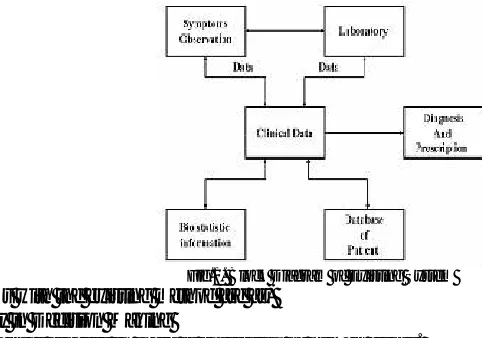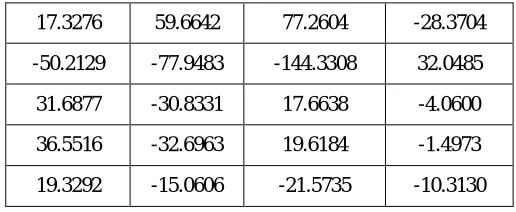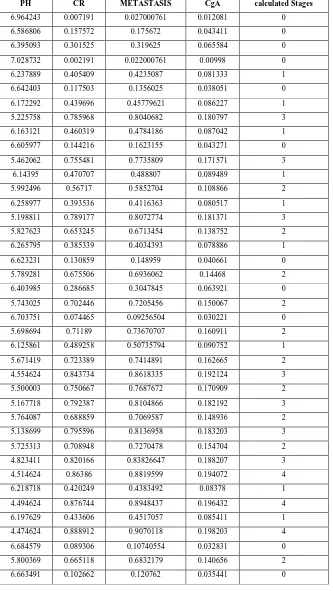Adaptive Neuro-Fuzzy System for Cancer
Sakshi Maskara, Arvinda Kushwaha, Shashank Bhardwaj
M.Tech Research Scholar, Department of Computer Science, HRIT Ghaziabad, Uttar Pradesh, India
Associate Professor and Dean Academics, Department of Computer Science, HRIT Ghaziabad, Uttar Pradesh, India
Assistant Professor, Department of Computer Applications, KIET Ghaziabad, Uttar Pradesh, India
ABSTRACT: Cancer is a disease which causes increasing of human death rate in each year. Cancer can be occurred anywhere in human body, normally. Even after being involvement of several tests, it is very difficult to obtain the ultimate diagnosis, also for medical expertise due to of lot of different parameters obtained from the subject to be diagnosed. A major class of problems in medical sciences involves the diagnosis of disease based upon various tests performed upon patient. Over the past few decades, this has given rise to computerized diagnostic tools, intended to aid physicians in making sense out of the confusion of data. Clinical oncologists make diagnostic decisions about Cancer patient based on past professional experiences and knowledge, intelligent techniques are possibly the only class of automatic technique powerful enough to emulate the expert’s choice. Due to their stable behavior in the presence of noise in precision and uncertainty, the ANN and ANFIS techniques could potentially obtain better results than classical methods.
KEYWORDS: Cancer, Simulation, ANN, ANFIS, Fuzzy, Computer Aided Diagnosis, Metastasis, Capacitance Relaxation, Catecholamine.
I. INTRODUCTION
A lot of the engineers and researchers interested in neural networks (NNs) and fuzzy logic (FL) increased, during the late 1980s, to introduce the NN and FL technologies into several application fields. [1] These two technologies are widely used and are considered fundamental technologies of engineering. Within several years, NN and FS fusing technologies were already being used in commercial products and industrial systems. Today these techniques are very popular in biomedical field like medical diagnosis. This work illustrates a reliable prediction methodology to diagnose Cancer disease and classify between different stages of Cancer using Adaptive Neuro Fuzzy Inference System (ANFIS) classification techniques [10].
ANFIS is a kind of hybrid of neural network and fuzzy logic and is based on Takagi–Sugeno fuzzy inference system. In ANFIS, we combine both the learning capabilities of a neural network and reasoning capabilities of fuzzy logic in order to give enhanced prediction capabilities [2]. Since it integrates both neural networks and fuzzy logic principles, it has potential to capture the benefits of both in a single framework. Its inference system corresponds to a set of fuzzy [3] IF–THEN rules that have learning capability to approximate nonlinear functions. Hence, ANFIS is considered to be universal approximator. The ANFIS model is very suitable and can generate excellent classification results provided that the right type and number of Membership Functions (MFs) are used in the classification task [4].In the classification [5] two different classification techniques are employed: an artificial neural network-based classifier and a hybrid ANFIS classifier. A neural classifier can learn from data, but the output does not lead itself naturally to interpretation. An ANFIS classifier is based on a three-layer feed-forward neural network and combines the merits of both neural and fuzzy classifiers while overcoming their drawbacks and limitations. The developed Adaptive Neuro Fuzzy Inference System (ANFIS) classifier exhibits high levels of accuracy, consistency and reliability, with acceptably low computational time and is a promising new development in the field of diagnosis of cancer.
II. RELATED WORK
The Existing system is a manual process which consumes weeks or months to diagnose the cancer patient from the clinical test data results that are being performed on them. The block diagram of the existing system is given in the figure 1. Figure 1 shows that a diagnosis of particular disease is being taken in clinics based on the symptoms and data taken through the laboratories. Based on diagnosed data a database is prepared.
Fig.1. Block Diagram of Existing System Other big problems with the existing method are as-
Uncertainty in Decision Making
As it’s a manual process so there is possibility of human errors.
Generates bewildering amount of data so the ultimate diagnose is very confusing.
III. RESEARCH MOTIVATION
A. Our aim to design an automatic system will surpass the shortcomings of the existing system that prevails till date i.e. it’s a time consuming system. Moreover, probability of error is much more in human computation as compared to automatic system. It is essential to know about stage of disease since proper treatment will depend on stage of cancer that patient is suffering from.
B. There are over 200 different types of cancer [11], each of which has a unique set of clinical characteristics, a specific treatment regime and a different chance of being cured (Khan et al. (2001)). Unfortunately, it is sometimes difficult for even the experienced specialists to tell the difference among particular cancer and their subtypes. Neuro-Fuzzy technology provides a much more robust diagnosis than traditional approaches available.
C. During the experimental studies, it is found that some data requires a large subset to present its property. This may cause too many rules. The research motivation is how to reduce the number of rules if the dataset is relatively large. D. Reducing the number of rules can also reduce the computational cost and training time, meanwhile discovering the
most important knowledge from the data.
E. The next motivation comes from the interpretability of NF models. Firstly, a NF system is a rule based system. It can summarize the knowledge from data and it also can be interpreted easily by using human linguistic rules.
These features may help the biology researchers to understand and summarize the knowledge behind data. Combined with the learning ability of NNs, NF models can automatically generate and adjust the linguistic rules from unknown data. This model can solve the problem before biologists even start to analyse the data.
IV. IMPLEMENTATION USING ANN TECHNIQUE
For training the Back propagation feed forward artificial neural network the data of 123 cancer patients is used. Number of iterations starting from 0 iterations will go up to 2111909 till sum error is greater than tolerance.
Table 1. Details of parameters used in ANN implementation
The ANN training is completed in 2111909 iterations with a tolerance of 0.1, the weights generated during training are Wih and Whj. If we further decrease the value of tolerance then the number of iteration and computational time will shoot up to very high values. Now, the training part has been completed. 123 samples have been used for training and a dataset of 40 patients is used for classification. The weights generated during training are Wih and Whj. Here Wih is the weight matrix between input and hidden layer and Whj is the weight matrix between hidden and output layer. The weight matrices generated after training are shown below in table 2.
Table 2. Weight matrix Wih [5*4] displaying weights between input and hidden layer.
V. RESULTS OF ANNCLASSIFICATION IN MATLAB
These weights are used for testing the data. The data is tested against these weights which are generated after training. The output obtained after testing is compared with the desired output and the misclassification or error percentage is calculated. The below table tells how the neural network classifies stage of cancer on giving inputs. Input data has been given column wise. The table of testing result is shown in table 3.
The table 3 shows input and output simulations of the ANN implementation in MATLAB. It has been found in most of the cases recalled stage is same as the actual stage.
The output we have selected as Stages of cancer. The number of membership functions used for input parameters are three and type of the MFs is trimf functions i.e. triangular shaped membership function for all four inputs. Each input Capacitance Relaxation, pH of cancer cell, CgA and Metastasis has given three functions low, medium and high as per the ranges limit. Number of input/output dataset pairs is decided to make the rules of the system. The learning process took step by step implementation and learning of various toolboxes in MATLAB, here Takagi-Sugeno-type fuzzy inference system is used.
No. of samples used for training 123
Momentum is taken 0.8
Learning Rate is taken 1.2
Error Tolerance .01
No. of neurons in hidden layer is
taken 4
No. of samples used for testing 40
Samples that gives error 1
Therefore, misclassification 1/40 * 100 = 2.5 %
No. of iterations taken 2111909
17.3276 59.6642 77.2604 -28.3704
-50.2129 -77.9483 -144.3308 32.0485
31.6877 -30.8331 17.6638 -4.0600
36.5516 -32.6963 19.6184 -1.4973
PH CR METASTASIS CgA calculated Stages
6.964243 0.007191 0.027000761 0.012081 0
6.586806 0.157572 0.175672 0.043411 0
6.395093 0.301525 0.319625 0.065584 0
7.028732 0.002191 0.022000761 0.00998 0
6.237889 0.405409 0.4235087 0.081333 1
6.642403 0.117503 0.1356025 0.038051 0
6.172292 0.439696 0.45779621 0.086227 1
5.225758 0.785968 0.8040682 0.180797 3
6.163121 0.460319 0.4784186 0.087042 1
6.605977 0.144216 0.1623155 0.043271 0
5.462062 0.755481 0.7735809 0.171571 3
6.14395 0.470707 0.488807 0.089489 1
5.992496 0.56717 0.5852704 0.108866 2
6.258977 0.393536 0.4116363 0.080517 1
5.198811 0.789177 0.8072774 0.181371 3
5.827623 0.653245 0.6713454 0.138752 2
6.265795 0.385339 0.4034393 0.078886 1
6.623231 0.130859 0.148959 0.040661 0
5.789281 0.675506 0.6936062 0.14468 2
6.403985 0.286685 0.3047845 0.063921 0
5.743025 0.702446 0.7205456 0.150067 2
6.703751 0.074465 0.09256504 0.030221 0
5.698694 0.71189 0.73670707 0.160911 2
6.125861 0.489258 0.50735794 0.090752 1
5.671419 0.723389 0.7414891 0.162665 2
4.554624 0.843734 0.8618335 0.192124 3
5.500003 0.750667 0.7687672 0.170909 2
5.167718 0.792387 0.8104866 0.182192 3
5.764087 0.688859 0.7069587 0.148936 2
5.138699 0.795596 0.8136958 0.183203 3
5.725313 0.708948 0.7270478 0.154704 2
4.823411 0.820166 0.83826647 0.188207 3
4.514624 0.86386 0.8819599 0.194072 4
6.218718 0.420249 0.4383492 0.08378 1
4.494624 0.876744 0.8948437 0.196432 4
6.197629 0.433606 0.4517057 0.085411 1
4.474624 0.888912 0.9070118 0.198203 4
6.684579 0.089306 0.10740554 0.032831 0
5.800369 0.665118 0.6832179 0.140656 2
VI. CONCLUSION AND FUTURE WORK
ANFIS and ANN architecture has been designed and implemented in this work. The applicability of artificial neural network and Adaptive Neuro fuzzy Inference System in classification of the stages of cancer was examined in this research work. The results demonstrated that large significant differences exist between the performances of back propagation feed forward neural network and hybrid algorithm ANFIS network system. The classification problem of diagnosis of cancer stages is discussed in the terms of accuracy, computational time and epochs. Apart from this, the ANFIS technique can be used in various field of robotics to determine the positions and orientations.
REFERENCES
1. Hazlina Hamdan and Jonathan M. Garibaldi, Adaptive Neuro-Fuzzy Inference System (ANFIS) in Modeling Breast Cancer Survival, Proceedings of the Special IEEE World Congress on Computational Intelligence (WCCI) 2010, Spain, July 18-23, 2010.
2. Kakar M, Nyström H, Aarup LR, Nøttrup TJ, Olsen DR., Respiratory motion prediction by using the adaptive neuro fuzzy inference system (ANFIS). Physics in Medicine and Biology, Vol. 50, Issue 19, pp. 4721-4728, 2005.
3. L.A.Zadeh, Fuzzy sets. journal of information Sciences, Vol. 8, pp. 338-353, 1965.
4. Hussain, S. Shahbudin, H. Husain, S. A. Samad, N. M. Tahir, A Simplified Shock Graph for Human Posture Classification Using the Adaptive Neuro Fuzzy Inference System.. Journal of Information & Computational Science, Vol.9, Issue 8, pp. 2035-2048, 2012. 5. Essam Al-Daoud, Cancer Diagnosis Using Modified Fuzzy Network. Universal Journal of Computer Science and Engineering
Technology, Vol. 1, Issue 2, pp. 73-78, 2010.
6. Kevin Hayden, pH Levels and Cancer, Alkaline and Acidic Foods, Featured Articles, Health, Food News, & Big Pharma, [online] Available at: http://www.truthistreason.net /ph-levels-and-cancer-alkaline-and-acidic-foods, 26 February 2012.
7. Bruce Armstrong, University of Sydney, [Online] Available at: http://www.cancerinstitute.org.au/patient-support/what-i-need-to-know/about-cancer/what-are-the-different-stages-of-cancer, July 2012.
8. Arshdeep Kaur, Amrit Kaur, Comparison of Mamdani-Type and Sugeno-Type Fuzzy Inference Systems for Air Conditioning System. International Journal of Soft Computing and Engineering (IJSCE), Vol. 2, Issue 2, pp. 323-325, 2012.
9. David Reby, SovanLek, IoannisDimopoulos, Jean Joachim, Jacques Lauga, SteÂphaneAulagnier, Artificial neural networks as a classification method in the behavioural sciences. Elsevier Science Behavioural Processes Journal, Vol. 40, Issue 1,pp. 35–43, 1997. 10. Davide Campana, Francesca Nori, LidyaPiscitelli, Antonio Maria Morselli-Labate, RaffaelePezzilli, Roberto Corinaldesi, and Paola
Tomassetti. Chromogranin A: Is It a Useful Marker of Neuroendocrine Tumors?. Journal Of Clinical Oncology, Vol. 25, Issue 15, May 2007.
11. DrParul R Sheth, [online], Available at: http://www.timeswellness.com/article/104/ 20120430201204041219118901fdea5a9/ Common-cancers-prevalent-in-India.html, 30 April 2012.
12. D. F. Brougham, G. Ivanova, M. Gottschalk, D. M. Collins, A. J. Eustace, R. O'Connor, J. Havel, Artificial Neural Networks for Classification in Metabolomic Studies of Whole Cells Using 1H Nuclear Magnetic Resonance. Journal of Biomedicine and Biotechnology, Vol. 2011, Article ID 158094, doi:10.1155/2011/158094, 2011.
BIOGRAPHY
Sakshi Maskara, is a research scholar in Computer Science Department at HRIT, Ghaziabad. She is perusing masters in computer science. Her research interests are in fuzzy logic networks and in medical problems related to diseases.
Arvinda Kushwaha is an Associate Professor and Dean Academics at HRIT, Ghaziabad. He received M.Tech (Software Engineering) from RGPV Bhopal and pursuing PhD from Jamia Millia Islamia (Central University). He is currently working in the areas of wireless Networks, with main focus on the Quality of Service (QoS) issues and challenges in wireless sensor networks and on Fuzzy Logic.


